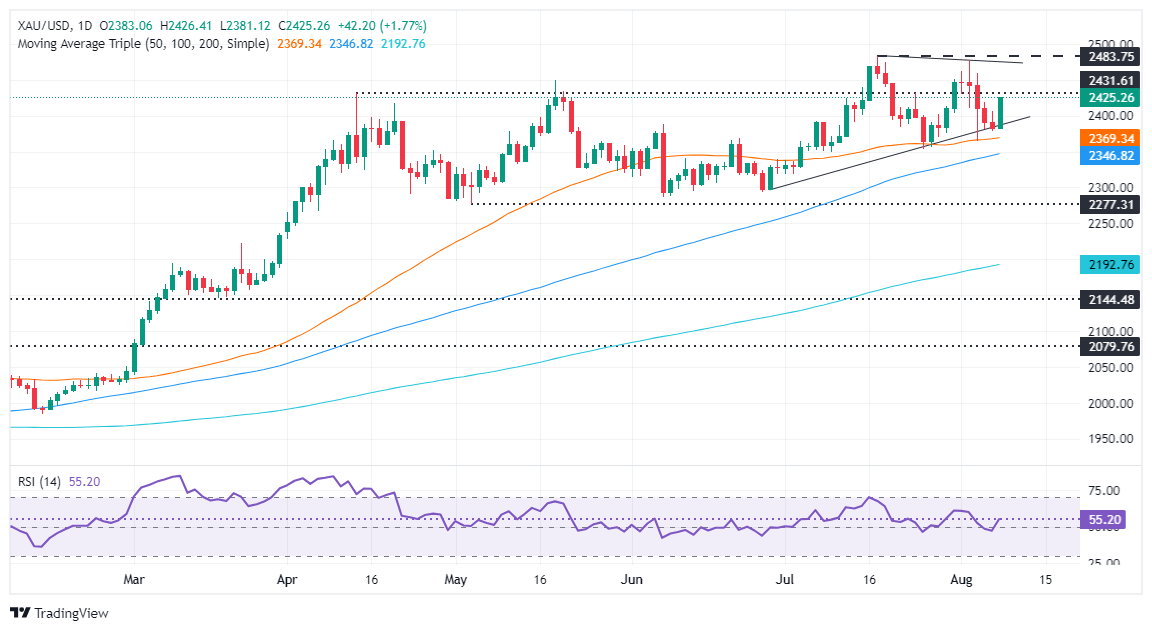Gold prices advance amid a strong US Dollar and high US yields
- Gold price rises past $2,400 figure, brushing aside US Dollar strength and high yields.
- US Initial Jobless Claims drop, Continuing Claims hit highest level since November 2021.
- Geopolitical risks from Iran and Lebanon's potential retaliation against Israel support Gold's allure.
Gold price climbed during the North American session on Thursday after solid data from the United States (US) underpinned the Greenback. Despite that, the precious metal brushed aside the strength of the US Dollar and the rise in US yields. At the time of writing, the XAU/USD trades at $2,419, up over 1.40%.
The US Bureau of Labor Statistics (BLS) released a solid jobs report, as the number of Americans applying for unemployment benefits dipped below estimates and last week's data, a tailwind for the Greenback.
Further data showed that Continuing Claims rose to their highest level since November 2021.
The buck reacted positively, as shown by the US Dollar Index (DXY), which tracks the American currency against six other currencies. It rose by 0.10% to 103.28, while the 10-year benchmark note yield pierced the 4.0% threshold.
Bullion is set to attract investors' interest amid heightened geopolitical risks due to the latest developments in the Middle East. Although the market mood remains positive, fears lurk that retaliation from Iran and Lebanon against Israel are forthcoming.
Daily digest market movers: Gold price on the defensive amid risk-on mood
- Worries of a US recession had faded after US Initial Jobless Claims for the week ending August 3 dipped from 250K to 233K, below forecasts of 240K. Continuing Claims through July 27 increased from 1,869K to 1,875K, exceeding the forecast of 1,870K.
- The golden metal price gathered traction despite reports that China’s central bank restrained itself from purchasing Gold for the third consecutive month.
- The CME FedWatch Tool shows that the odds for a 50-basis-point (bps) cut at the September meeting were lowered from 63.5% on Wednesday to 57.5%.
- The Fed decided to hold rates unchanged last week but indicated that favorable data on inflation and further weakening in the labor market could prompt action.
Technical analysis: Gold price counterattacks and rises toward $2,450
The XAU/USD rallies sharply, breaking new weekly highs of $2,424, with buyers eyeing the psychological $2,450 level mark. The Relative Strength Index (RSI) shows buyers are gathering momentum, meaning higher prices are on the cards.
If buyers push prices above $2,450, the next stop would be the August 2 high at $2,477, ahead of testing the all-time high at $2,483. On further strength, the $2,500 figure is up for grabs.
On the other hand, if XAU/USD drops below the 50-day Simple Moving Average (SMA) at $2,368, this would exacerbate a drop to the 100-day SMA at $2,346, followed by a support trendline around $2,316. Once cleared, the next support would be $2,300.

Gold FAQs
Gold has played a key role in human’s history as it has been widely used as a store of value and medium of exchange. Currently, apart from its shine and usage for jewelry, the precious metal is widely seen as a safe-haven asset, meaning that it is considered a good investment during turbulent times. Gold is also widely seen as a hedge against inflation and against depreciating currencies as it doesn’t rely on any specific issuer or government.
Central banks are the biggest Gold holders. In their aim to support their currencies in turbulent times, central banks tend to diversify their reserves and buy Gold to improve the perceived strength of the economy and the currency. High Gold reserves can be a source of trust for a country’s solvency. Central banks added 1,136 tonnes of Gold worth around $70 billion to their reserves in 2022, according to data from the World Gold Council. This is the highest yearly purchase since records began. Central banks from emerging economies such as China, India and Turkey are quickly increasing their Gold reserves.
Gold has an inverse correlation with the US Dollar and US Treasuries, which are both major reserve and safe-haven assets. When the Dollar depreciates, Gold tends to rise, enabling investors and central banks to diversify their assets in turbulent times. Gold is also inversely correlated with risk assets. A rally in the stock market tends to weaken Gold price, while sell-offs in riskier markets tend to favor the precious metal.
The price can move due to a wide range of factors. Geopolitical instability or fears of a deep recession can quickly make Gold price escalate due to its safe-haven status. As a yield-less asset, Gold tends to rise with lower interest rates, while higher cost of money usually weighs down on the yellow metal. Still, most moves depend on how the US Dollar (USD) behaves as the asset is priced in dollars (XAU/USD). A strong Dollar tends to keep the price of Gold controlled, whereas a weaker Dollar is likely to push Gold prices up.